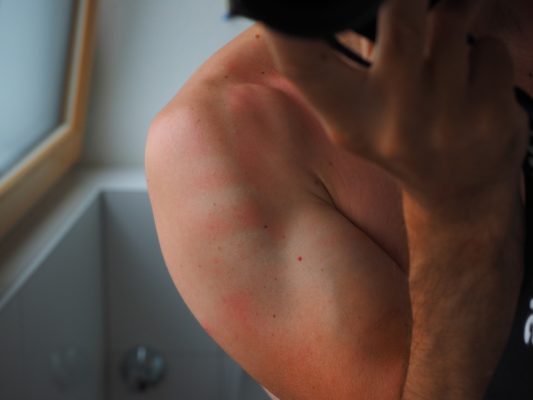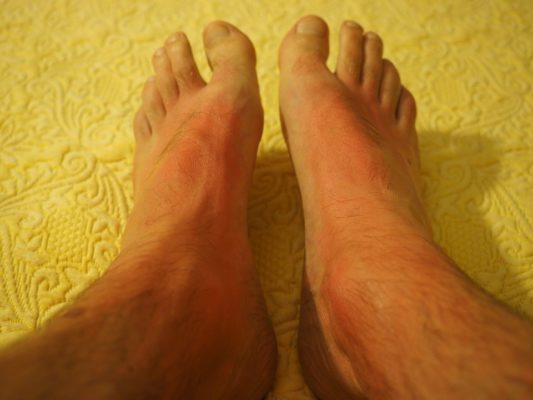A tanning bed can be a huge lifesaver for all those who want to have a glowing tanned skin. However, when it comes to the real deal, especially for first-timers, an unfortunate side-effect they would have to deal with are tanning bed rashes.
Most of us might have felt itchy after tanning for the first time. These rashes after tanning, if not properly treated, will lead to dangerous skin problems.
Don’t get tensed guys.
It’s not a big issue as projected by many. You can easily prevent it, detect it fast and can cure it with ease.
In this article, we will see tanning bed rash symptoms, causes and how to get rid of tanning bed rashes.
Table of Contents
What is a Tanning Bed Rash?
It’s just been a couple of days for you in the tanning bed when suddenly you notice a few itchy scars or rashes on your skin. If it was something which was there one day and vanished the next moment, you probably would not worry about it. But what if it isn’t?
Though a nasty surprise, this stubborn break out could very well be a tanning rash.
A tanning bed rash is one or a series of red or even discolored itchy spots or bumps on your skin. To be honest with you, these rashes or itchy skin is very common if you are a regular user of tanning beds.
But worry not! You don’t need to get paranoid about those uncomfortable bumps on your body. With the right tips and treatments, you can easily say goodbye to them!
It may be called a tanning bed rash, but that does not mean they are all heat rashes.
Causes for Tanning Rashes
Tanning bed rashes are not something which appears all of a sudden. It usually develops gradually, and that is what makes it difficult to identify the type you are having.
These are some of the possible explanations for the breakouts you are having:
1. Very Common in Dry skinned People
Have you noticed any flaky rashes on your skin lately? Then chances are that you are more likely having a dry skin rash. Having a dry skin is the most common reason for a tanning bed rash.
It is when you don’t moisturize your skin enough that you start seeing these types of rashes on your body. Still not sure how?
A tanning bed not just helps you get a tan, but also zaps the moisture from your skin. If you are getting into the bed with dry skin, you can end up feeling dehydrated and with a bad skin rash.
2. Sweat buildup on Your Skin
A heat rash (Milaria) is another kind of skin rash caused by the bed. It may be hard to imagine something like this happening, but it sure can!
At times, tanning beds can even affect the free flow of sweat. Unable to flow freely, they get trapped in between the different layers of your skin. This will eventually build up and irritate your skin, causing a heat rash.
3. Overexposure- The Most Common Cause
Overexposing the tanning rays is the most common reason for most of the tanning bed rashes. While a tanning bed is the quickest way to secure a bronze look, it does come with its own set of risks.
There is only a certain amount of exposure to ultraviolet rays that our body can handle, and these beds have the capacity to offer that and more. Unfortunately, most of the rays emitted by the bed are harmful ones.
If you are a tanning addict who uses it every other day, it puts you at the risk of burning yourself and getting a bed rash due to overexposure. Not just a rash, it can lead to other harmful side-effects like skin cancer.
4. Allergies
How can anyone relate tanning beds with allergies? It may be unlikely, but not impossible!
What if it is just that the tanning bed/booth isn’t suiting your skin? Lack of proper hygiene in tanning beds can also cause your skin to break out in rashes.
For instance, it is very normal for people to sweat while using the bed. This sweat can trickle down to the surface of the bed. If the bed is not cleaned regularly, the sweat which accumulates every time on the bed can dry up after a while and irritate your skin, causing rashes to appear.
Your rashes could even be an allergic reaction to the tanning oil or lotion you are using while on the bed. An umbrella term which deals with the different allergens is contact dermatitis.
5. Light Sensitivity Disorder
There is a reason that this was put last in the list, and that is because it is a very rare occurrence. That means it is highly unlikely for this to be the reason for your rash unless you don’t see any other possible explanation.
LSD is very similar to an allergic reaction to UV rays, wherein people can’t even tolerate small amounts of it.
Now that you are familiar with the causes, let us continue with the symptoms of these rashes one by one.
Symptoms of Tanning Itchiness
Just as the causes vary, the symptoms are also different for each kind of rash.
Are you having a scaly or just plain itchy bump, which feels dry to the touch? Then it could most probably the symptom of rash caused by dryness.
If it is a case of sweat buildup, it is again easy to recognize. Heat rashes are not called prickly heat for anything! More than just feeling prickly, the rash can be anywhere between a small blister to a huge red bump.
The symptoms of a tanning bed rash caused due to overexposure look more precisely like sunburn. This can range from slight itchy and discolored blisters to huge red blotches. It could be painful as well.
What are the Effects of Tanning Bed Itches?
Trying to get rid of a heat rash is not as simple as dealing with a painful pimple. The more severe the rash, the more effect it has on the person.
Painful heat rashes are of course a source of worry. It not just causes discomfort to the one having it, but can even destroy his sense of confidence.
After all how much can one hide their rashes under makeup? And, it definitely does not look good on your skin!
Now that you know the different types of tanning bed rashes along with their causes and symptoms, are you ready to find out how to get rid of them?
How to Get Rid of Tanning Bed Rash Fast
Taking steps to get rid of a rash will depend mostly on the kind of one you are suffering from. The steps are as follows:
- Identify the reason for the rash
- Avoid the source
- look at other alternatives and remedies
Treating a rash is not like dealing with your mundane pimple. After all, you can’t treat all kinds of rashes in the same way!
That does not mean you need to straightaway go to a medical specialist as soon as you notice a bump on your skin. It’s always good to get expert advice, but it’s best to try out your own quick fixes first to get rid of those troublesome rashes!
Identifying the type of rash
By now, you already know that finding out the kind of rash goes beyond its appearance. Just analyze and try to find out when your skin started feeling irritated and when it started feeling better. Was it after you applied that tube of particular lotion, or was it during your time on the bed?
Let me give you a simple example of the same. Imagine that you started developing a rash while using the tanning bed. Still not sure of the reason, you decide to ditch the bed for outdoor tanning, but find the rashes still there and probably even getting worse. You think it over and finally, identify it as a heat rash.
More often than not, one can determine the cause by analyzing facts.
Avoiding the cause
In any kind of rash, the first step of treatment is as simple as avoiding the cause.
For instance, if you feel it is due to overexposure, avoid tanning by all means. Unfortunately, the same holds true if it is due to LSD, if you are still desperate for a tanned look, there are still not so risky alternatives like sunless or spray tanning.
If the bed is causing the breakouts, avoiding it would have an instant reaction with the rashes getting lighter very quickly. No matter what is causing your break outs, the best thing to do first is to totally quit tanning, whether on a bed or under the sun.
Rashes would normally go away within 24 or maximum by 48 hours. This could happen more quickly if you totally avoid the source of irritation.
Other remedies
In the meantime, you can also look at other natural remedies for treating and curing these rashes. Try a cold compress or just a relaxing cool shower. More than just cooling your skin, this will also soothe your irritated area.
Applying calamine lotion a few times a day on the affected areas can also help reduce inflammation and itchiness.
Now, why don’t we try out other ways to get rid of those bothersome breakouts? While a cool shower seems a very obvious remedy, there are a number of natural cures that you may not be aware of:
Aloe Vera
You have probably heard a lot about the benefits of this plant. As much as it is good for your hair, it helps soothe your skin as well. Apply a bit of Aloe Vera gel on the affected area and you are sure to feel much better.
Oatmeal
How many of you knew that Oatmeal is more than just a great snack/breakfast? Oatmeal works great for rashes, and contains avenanthramides which have anti-inflammatory properties.
Now you know why you ‘Oat’ to take that bowl of oatmeal! You can use it in either of the following ways, depending on the severity of your rash and based on your comfort.
- An oatmeal bath
Prepare a cool bath which is enough to submerge the affected areas of your rash. Add a few cups of ground and raw oatmeal to the water. Relax and stay in the tub for 30 to 60 minutes.
Wipe it off before applying a moisturizer.
- Prepare a paste
Add warm water into a bowl of organic oatmeal and stir it till it becomes a thick paste. You can also cook the oatmeal if you want. Apply this mixture on the affected areas and let it dry.
Wipe it off before applying a moisturizer.
Olive oil
If your rash is caused by dry skin, then this is the perfect home remedy for you. Olive oil hydrates the skin, reducing the rash as well. This can help almost every time since dryness is something which is associated with any kind of rash.
Baking soda
Adding a few spoons of baking soda or cornstarch in your bath can boost your pH levels and relieve any type of sunburns.
Yogurt
This not just cools your skin, but also soothes inflammation and sunburn. It also works as a great cleanser, getting rid of the irritants in your skin.
Cucumber
This veggie has cooling and healing effects when put on rashes. With its hydrating properties, this would be the best way to combat dry skin rashes.
Apple Cider Vinegar
This vinegar helps increase the PH levels in your skin and heal sunburn. You can either drink it or apply it to your skin.
Potato
Applying potato paste on your skin helps relieve pain and inflammation caused by minor rashes and sunburn.
There are a few more products like green tea, chamomile, and coriander to beat a rash. However, the ones mentioned above have the highest odds of curing a rash.
How to Prevent Itchy Skin After Tanning?
For some of you suffering from allergic rashes, the only option may be to look at sunless or spray tanning, at least for the time being. But for the others, it is easy to keep tanning sans the side-effects of a rash! These are a few steps to ensure a problem free tanning session:
Sun protection
We just can’t stress enough on this! This is the first and foremost thing you need to take care while out tanning. Sometimes not having enough protection is enough for a breakout to happen.
Make sure that you have your eye goggles on. Remember, your eyelashes and eyelids can block only a small amount of radiation. So, just closing your eyes isn’t enough!
This may seem unrelated to rashes, but you might want to protect your hair as well! UV rays can have adverse effects on not just your hair but also the skin under it. So, better wear a shower cap while on the bed.
Another must is a sunscreen. Rather than blocking the UV rays entirely, a good quality sunscreen supports your tanning process but prevents the harmful rays from penetrating too deep into the skin. One thing you need to be aware of while choosing a sunscreen is the SPF range.
The more sensitive your skin, the higher SPF product you need to choose. You can either choose a sunscreen or a tanning lotion with sunscreen, which is a better option.
Moisturizing
Just applying generous quantities of moisturizer on your skin can help prevent a potential dry skin rash. Your skin needs proper hydration and moisturizing in order for it to stay soft and supple. So love your skin and moisturize it daily!
Use good quality products
Always make sure that you use good quality products. It is better to use an expensive high-quality lotion (find it here) than use an inferior product and suffer the side-effects!
We also recommend you to use hygienic and healthy tanning beds. Buying a tanning bed is never a bad idea if you are a lover of the tanned body. It will definitely pay off in the long run and will ensure safe tanning.
Drink plenty of water
Your fluid intake matters as much as how you pamper your skin. Water makes up 70 pc of your body. So the more water you drink, the more it helps your skin.
It keeps the skin hydrated and healthy, which can help prevent and ward off many tanning bad side effects including rashes.
Exfoliate
Exfoliating your skin helps unclog and clean your pores, thus getting rid of any dead cells. So, not exfoliating properly or not doing it frequently enough can cause blocked pores, and, you guessed it right, itchy skin and rashes!
Don’t go overboard!
Last but not the least, don’t use them too often! Tanning beds are a great way for getting a quick tan, but that doesn’t mean you can use it every now and then.
It’s when you get addicted to the idea and use it too regularly that the harmful side effects start showing up. They can be anything from a small rash to a deadly disease like skin cancer.
Hope you now have an in-depth idea about tanning rashes, its causes, treatments, symptoms, and treatment. If you are a tanning enthusiast, now you know it’s not that difficult to prevent a tanning bed rash while maintaining a gorgeous bronze tan!
With all the modern day tanning products and the tips mentioned above, tanning is sure to be a wonderful experience! So, what are you waiting for?
Happy tanning!



